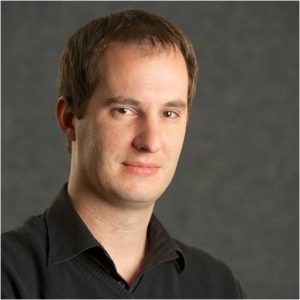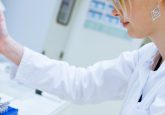2016 New Investigator: Karl Storbeck

 Nominee:
Nominee:
Nominated By:
Supporting Comments:
What made you choose a career in bioanalysis?
I was first introduced to the subject of Biochemistry in high school, while attending a science week as a finalist of the National Science Olympiad in South Africa. It was immediately clear to me that the subject combined my interest in biology and chemistry and I decided there and then that I would pursue a career in biochemistry. During my PhD I was face with the challenge of separating and quantifying an array of steroid hormones and decided to use UPLC–MS and have not looked back since. UPLC–MS/MS and now UPC2–MS/MS have become invaluable tools in my research.
Describe the main highlights of your bioanalytical research, and its importance to the bioanalytical community.
We have discovered a novel pathway for the metabolism of the steroid 11β-hydroxyandrostenedione (11OHA4), a major product of human steroidogenesis which has been ignored for decades. We showed that 11OHA4 is the precursor to the potent androgens 11-ketotestosterone (11KT) and 11-ketodihydrotestosterone (11KDHT). Using a combination of UPLC–MS and UPLC–MS/MS techniques we confirmed the existence of a number of novel steroids in this pathway. We have since shown that 11KDHT is as potent as DHT, previously considered to be most potent natural androgen, a finding which has significant implications for our understanding of androgen dependent diseases such as castration-resistant prostate cancer and diseases of androgen excess, such as congenital adrenal hyperplasia and polycystic ovary syndrome.
Currently my laboratory is developing UPC2–MS/MS based methods for steroid analysis and is one of the first laboratories to do so. Our results (under review) show that UPC2–MS/MS offers superior selectivity and chromatographic efficiency compared to UPLC–MS/MS and drastically reduced run times compared to GC–MS. Our findings will be of significant benefit to endocrine laboratories as there is currently a drive to phase out immunoassays in favour of MS. We believe that UPC2–MS/MS will offer GC–MS like results, but with the benefit of lower costs and high-throughput
What is the impact of your work beyond your home laboratory?
Our discovery that 11OHA4 is the precursor to potent androgens has received much international attention. For example a recent publication by Turcu et al in the European Journal of Endocrinology has shown that these 11-oxygenated steroids may be responsible for the androgenic effects observed in patients with 21-hydroxylase deficiency, a common endocrine disorder.
In addition, we were one of the first, if not the first, steroid laboratory to make use of UPC2–MS/MS. Dr Angela Taylor the lead analyst in the laboratory of Prof Wiebe Arlt, a world leader in steroid endocrinology, visited my laboratory in 2014. As a result of this exchange Prof Arlt has purchased a UPC2–MS/MS system and we have applied for a grant to compare the use of UPC2–MS/MS for steroid analysis to GC–MS and UPLC–MS/MS. Based on our preliminary findings (under review) we believe that UPC2–MS/MS can revolutionize the analysis of steroid hormones in endocrine laboratories.
Describe the most difficult challenge you have encountered in the laboratory and how you overcame it.
When we first had the idea that 11OHA4 was a precursor to active androgens we were able to propose a pathway for its metabolism based on the enzymatic activities of the steroidogenic enzymes. The problem we were faced with was that many of the intermediates and products we proposed were not commercially available. I therefore developed a method whereby we would incubate appropriately transfected nonsteroidogenic HEK293 cells with the precursors in order to enzymatically produce the proposed steroids. The conditioned media was then transferred to cells expressing the next enzyme in the pathway in order to investigate the metabolism of the novel steroids. The identity of the novel steroids was confirmed by accurate mass measurements using UPLC–MS. Using MSE technology we were able to identify daughter ions for the novel steroids. These were then used to set up MRM’s on our UPLC–MS/MS system enabling us to track the metabolism of the novel steroids without standards. Response factors were determined allowing the quantification of the novel steroids based on the standard curves of their parent steroids.
Describe your role in bioanalytical communities/groups.
I am actively involved in training postgraduate students in UPLC–MS/MS and UPC2–MS/MS. After testing a demo UPC2–MS/MS in 2014 I was instrumental in writing the grant which allowed Stellenbosch University to purchase the system, which is the first in Africa. I have since actively promoted the use of UPC2–MS/MS for steroid analysis by presenting our results at international conferences (including the 17th Congress on the Adrenal Cortex, Boston, USA) and during invited talks to other institutes (including the Institute for Metabolism and Systems Research, University of Birmingham, UK and the Fred Hutchinson Cancer Research Center in Seattle, USA) and within the South African Chromatography community (invited talks to ChromSA and ChromSA Western Cape). Furthermore, Prof Wiebke Arlt, a world leader in steroid analysis and endocrinology, and I have applied for a grant to compare the use of UPC2–MS/MS for steroid analysis to GC–MS and UPLC–MS/MS. Based on our preliminary findings (under review) we believe that UPC2–MS/MS can revolutionize the analysis of steroid hormones in both research and clinical laboratories by offering a low cost high-throughput technology with superior selectivity and sensitivity.
Please list up to five of your publications in the field of bioanalysis:
- Storbeck K, Kolar NW, Stander M, Swart AC, Prevoo D, Swart P. The development of an UPLC-coupled atmospheric pressure chemical ionization mass spectrometry assay for seven adrenal steroids. Anal. Biochem.372,11–20 (2008).
- Storbeck K, Bloem LM, Africander D, Schloms L, Swart P, Swart AC. 11β-Hydroxydihydrotestosterone and 11-ketodihydrotestosterone, novel C19 steroids with androgenic activity: A putative role in castration resistant prostate cancer? Mol. Cell. Endocrinol., 377, 135–146 (2013).
- A.C. Swart and K. Storbeck. 11β-hydroxyandrostenedione: downstream metabolism by 11βHSD, 17βHSD and SRD5A produces novel substrates in familiar pathways. Mol. Cell. Endocrinol. 2015, 408, 114–123.
- Bloem LM, Storbeck K, Swart P, du Toit T, Schloms L, Swart AC. Advances in the analytical methodologies: Profiling steroids in familiar pathways-challenging dogmas. J. Steroid Biochem. Mol. Biol.153, 80–92 (2015).
- Quanson JL, Stander MA, Pretorius E, Taylor AE, Storbeck K. The quantification of adrenal C19 metabolites by ultra-performance convergence chromatography tandem mass spectrometry (UPC2–MS/MS). Presented at: The 17th Congress on the Adrenal Cortex Conference. Boston Massachusetts, USA. 29–31 March 2016 (Poster).
Please select one publication from above that best highlights your career to date in the field of bioanalysis and provide an explanation for your choice.
Storbeck K, Bloem LM, Africander D, Schloms L, Swart P, Swart AC. 11β-Hydroxydihydrotestosterone and 11-ketodihydrotestosterone, novel C19 steroids with androgenic activity: A putative role in castration resistant prostate cancer? Mol. Cell. Endocrinol., 377, 135–146 (2013).
This was the first study to show the production of 11β-Hydroxydihydrotestosterone (11OHT), 11KT and 11KDHT from 11OHA4 in the context of human physiology. A variety of UPLC–MS and UPLC–MS/MS methods were employed to investigate the metabolism of 11OHA4 and confirm the existence of a number of novel steroids. This work was challenging due to the lack of commercial standards for the novel steroids, but also very rewarding as our findings have significant implications for our understanding of androgen dependent diseases such as castration resistant prostate cancer and diseases of androgen excess, such as congenital adrenal hyperplasia (CAH) and polycystic ovary syndrome.
Find out more about this year’s New Investigator Award, the prize, the judging panel and the rest of our nominees.

